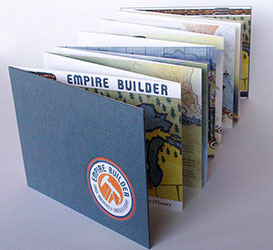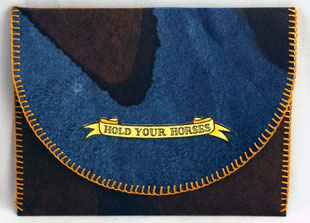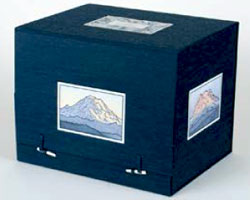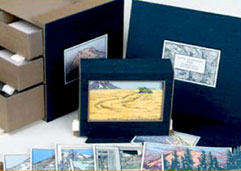
| Anagram Press ~ Washington (Chandler O'Leary 1982 - 2023 ) |
Share this page: |
| Chandler O'Leary: " My work is detailed, layered, labor-intensive, painstakingly researched, graphic in style, and often evocative of a strong sense of place. My design approach usually begins with historical research, to create a connection to the past and reinforce current relevance. Drawing is a major component of both my process and my finished work; mark-making brings evidence of the hand in direct relation with the conceptual components of each piece. My projects often develop in the form of a series, and build a narrative through sequential imagery." | |
| Empire Builder By Chandler O'Leary and Carol Inderieden Tacoma, Washington: Anagram Press/ Goat Back Press, 2015. Edition of 50. 7 x 9" closed, extends to 15 feet; 20 pages including pastedowns. Accordion structure. Digitally printed from watercolor illustrations on archival, 100% cotton paper. Handbound paper over boards. In paper slipcase. Signed by both artists and numbered. Empire Builder is a collaboration between artists Carol Inderieden and Chandler O'Leary; both contributed text and illustrations. The two artists lament the changes they have seen in the American West, changes driven by the thirst for oil and natural gas, changes spawned by fracking in North Dakota and ending in oil refineries of Washington. It is the story of tunnel vision and the attendant environmental consequences. The book "reads like a map – tracing both the route of the Empire Builder train and the path of industry and destruction, in one long, unbroken line." Colophon excerpts: "Seeing the Elephant was a figure of speech that came to embody the pioneer experience during the era of westward expansion. To see the elephant was to embark on a quest for riches and prosperity. It alluded to the danger and excitement associated with seeking one’s fortune in an unknown land. The elephant is an illusion, an impossible promise like a desert mirage that disappears as one moves closer. ... "If the American map were the Elephant writ large, it is the railroad that breathes life into the creature. Throughout the last century of rail development, the anatomical structure of a complex organism has evolved. Today spurs and trunk lines follow a vascular system that carries a lifeblood of raw materials across the nation in a never-ending stream of freight. While the Elephant’s lungs fill with natural gas, its veins run gold with domestic oil and its heart beats ever faster in the Bakken Formation of western North Dakota. "Even in today’s age of dwindling resources and dire environmental warnings, Americans still see the land as a bottomless well to be tapped. In the Bakken, a new frontier has opened and is flooded once again with a new generation of fortune-seekers. ... "The backbone of the modern Elephant is the railroad line from Chicago to Seattle — incidentally, the same line that carries the Empire Builder passenger train. This train is aptly named for the exploits of James J. Hill, the railroad lumber baron who grew rich transporting timber and other raw materials from the Pacific Northwest to the cities and industries of the Midwest. Today one can ride the Empire Builder from one end of Hill’s domain to the other, and witness every element of the fracking process along the way. In the early 20th century, the Empire Builder encouraged travelers to 'See America First' and marvel at the wonders of the natural world speeding past their windows. Today’s rail passengers watch the new Industrial Revolution rolling by. "This book is an attempt to articulate our dismay at the rapid transformation of a West we know and remember. We live and work at opposite ends of the Empire Builder railroad line: Carol in the Driftless Region of Wisconsin, where the bluffs and hillsides are being strip mined for frac sand; and Chandler in the Puget Sound area of western Washington, where Bakken oil is refined and shipped to other ports by tanker vessel. We both have personal ties to the northern Plains, though recent events render the region unrecognizable when compared to our memories. Still, the railroad connects us to each other and the landscapes we love. For the pioneers of the new era, the rhythm of the railroad is the marching song of progress — but for us, it is a lament." $600 |
|
| Anagram Press Out of Print Titles: | |
| Hold your Horses By Chandler O'Leary Tacoma, Washington: Anagram Press, 2013. Edition of 57. 7.5 x 5.75"; 13 cards. Letterpress printed and individually hand-painted. Housed in a saddlebag envelope with hand stitching along the seams and edges. A herd of twelve steeds corralled in a paper saddle-bag. Chandler O'Leary, Colophon: "I am not a member of the horsey set. I grew up far too poor for riding lessons, and I can't claim ever to have used the phrase 'saddle up' in the literal sense. Yet horses are as much a part of me as of any American who ever looked westward in wonder. They are living symbols of the wildness that still infuses our deepest desires - even if they no longer permeate our everyday culture. "I never had a pony as a child, but now I can boast a round dozen. Enclosed here is my very own horsey set, displayed in an equine rainbow of dapple grays, strawberry roans, pale palominos, skewbald bays, and rich chestnuts. This assembly gathers an assortment of traits and histories to tell the story of our fascination with horses. Each mount stands surrounded by the trappings of its trade or the symbols of its origins." (SOLD/Out of Print) |
|
Local Conditions An interactive artist book, capturing the changing faces of Mt. Rainier. Illustrated and compiled from data collected in person, on location, from 2008 to 2010. Letterpress printed, hand-watercolored, housed in a set of drawers with nested stab-bound book and Japanese-style outer wrapper. When the book is fully closed, it resembles a cube; the faces of the closed book contain illustrated labels corresponding to the North, South, East and West faces of Mt. Rainier, each depicting the mountain at sunset. The frontispiece containing the title of the book is at the top of the closed wrapper, and depicts a topographic map of the summit of Mt. Rainier. In homage to the color palette of Katsushika Hokusai’s Mt. Fuji series, all text and images are letterpress printed in indigo ink. Images and topographic map patterns are hand-drawn and watercolored; image flats are hand-cut. |
|
Page last update: 12.24.2024
Home | About Us | Contact Us | New Arrivals | Fine Press & Artists' Books | Broadsides |Resource Books | Order/Inquiry
Copyright © 2023 Vamp & Tramp, Booksellers, LLC. All rights reserved.



